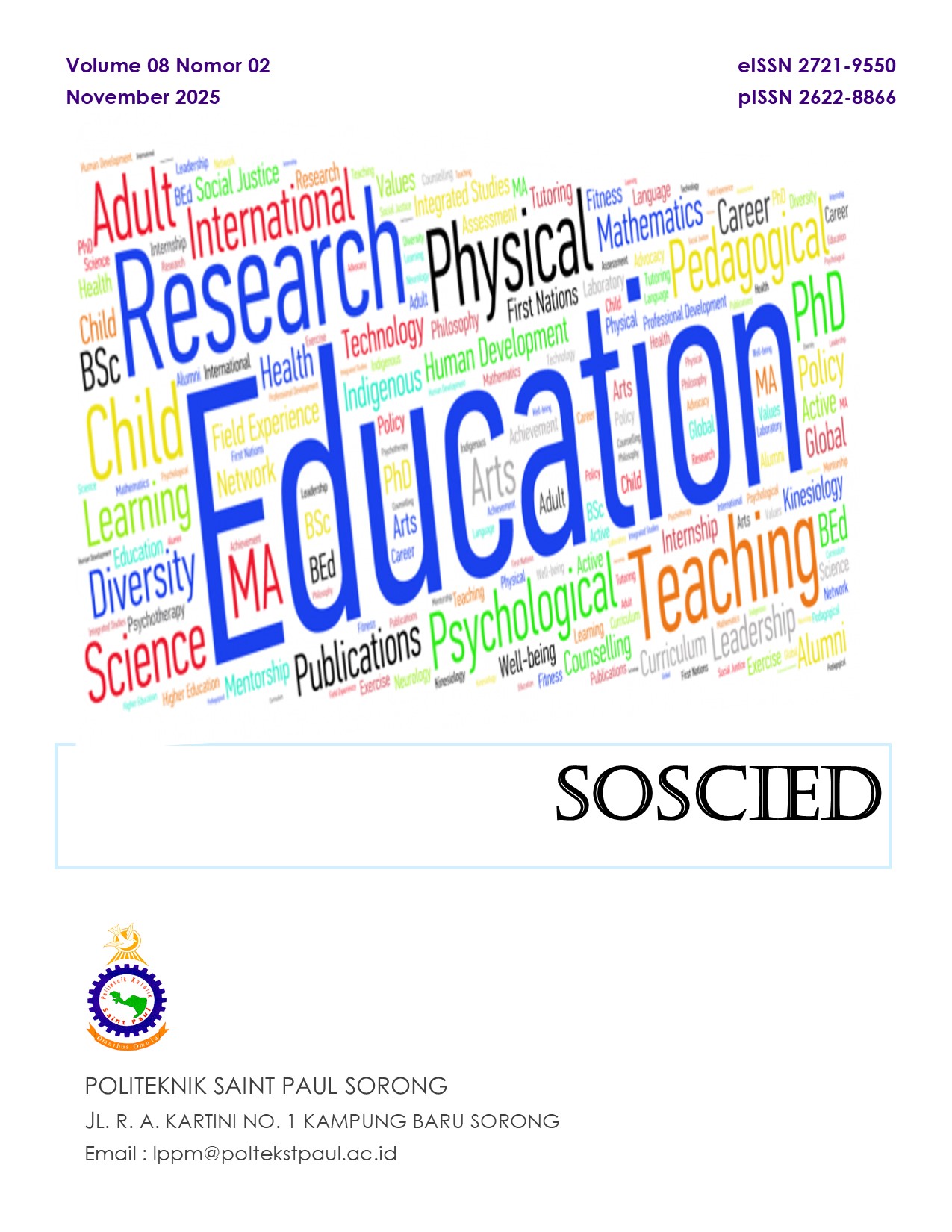ANALISIS LINGUISTIK DIGITAL DALAM KONTEN FACEBOOK PRO: POLA PENGGUNAAN BAHASA IBU MUDA DI DUSUN GARANTIGA DAN HUBUNGANNYA DENGAN ENGAGEMENT AUDIENS
Main Article Content
Abstract
This study aims to analyze the linguistic patterns used by young mothers in Dusun Garantiga, Maros Regency, on Facebook Pro content, and to examine the relationship between digital writing and speaking skills and audience engagement levels. The research employs a descriptive quantitative approach with digital linguistic analysis. Data were collected through digital observation and online documentation of 120 posts from ten selected Facebook Pro accounts using purposive sampling. The data were analyzed using descriptive statistics and Pearson and Spearman correlation tests with SPSS 25 for Windows. The results show that the linguistic patterns of young mothers’ digital communication are dominated by code-mixing (35%), informal style (28%), and netspeak (18%), indicating the use of casual greetings, abbreviations, emojis, and hashtags to create social closeness with audiences. Correlation analysis revealed a significant positive relationship between digital writing and speaking skills and engagement levels (r = 0.642; p < 0.05). Communicative and expressive language use was found to increase audience interactions such as likes, comments, and shares. Theoretically, this research enriches digital linguistics studies by highlighting community-based communication practices that have received limited academic attention. Practically, the findings offer recommendations for developing community-based digital communication literacy, particularly empowering young mothers in rural areas to utilize social media effectively as a medium for social and economic empowerment
Article Details
How to Cite
Amir, J., Dalle, A., & Sumarni, S. (1). ANALISIS LINGUISTIK DIGITAL DALAM KONTEN FACEBOOK PRO: POLA PENGGUNAAN BAHASA IBU MUDA DI DUSUN GARANTIGA DAN HUBUNGANNYA DENGAN ENGAGEMENT AUDIENS. SOSCIED, 8(2), 497-505. https://doi.org/10.32531/jsoscied.v8i2.1045
Section
Articles

This work is licensed under a Creative Commons Attribution-NonCommercial 4.0 International License.
LPPM Politeknik Katolik Saint Paul Sorong
References
Kaplan, A., & Haenlein, M. (2020). Rulers of the world, unite! The challenges and opportunities of artificial intelligence. Business horizons, 63(1), 37-50. https://doi.org/10.1016/j.bushor.2019.09.003
Van Dijck, J., Poell, T., & De Waal, M. (2018). The platform society: Public values in a connective world. Oxford: Oxford university press.
Kreutzer, R. T. (2021). Social media und social-media-marketing. In Social-Media-Marketing kompakt: Ausgestalten, Plattformen finden, messen, organisatorisch verankern, 1-21. Wiesbaden: Springer Fachmedien Wiesbaden. https://doi.org/10.1007/978-3-658-33866-4_1
Tagg, C. (2015). Exploring digital communication: Language in action. London: Routledge. https://doi.org/10.4324/9781315727165
Farkas, X., & Bene, M. (2021). Images, politicians, and social media: Patterns and effects of politicians’ image-based political communication strategies on social media. The international journal of press/politics, 26(1), 119-142. https://doi.org/10.1177/1940161220959553
Zappavigna, M., & Logi, L. (2021). Emoji in social media discourse about working from home. Discourse, Context & Media, 44, 100543. https://doi.org/10.1016/j.dcm.2021.100543
Herring, S. C. (2012). Grammar and electronic communication. The encyclopedia of applied linguistics, 1-9.
Crystal, D. (2011). Internet linguistics: A student guide. London: Routledge. https://doi.org/10.4324/9780203830901
Nasrullah, R., Aditya, W., Satya, T. I., & Hanifah, N. (2017). Materi pendukung literasi digital. Jakarta: Kementerian Pendidikan dan Kebudayaan.
Maity, K., Saha, S., & Bhattacharyya, P. (2022). Emoji, sentiment and emotion aided cyberbullying detection in hinglish. IEEE Transactions on Computational Social Systems, 10(5), 2411-2420. https://doi.org/10.1109/TCSS.2022.3183046
Kumar, Y., Kaur, K., & Kaur, S. (2021). Study of automatic text summarization approaches in different languages. Artificial Intelligence Review, 54(8), 5897-5929. https://doi.org/10.1007/s10462-021-09964-4
Naila, T. M., & Rohimi, P. (2024). Konsumsi Media Dan Identitas Budaya Di Kalangan Remaja Juwana, Kabupaten Pati. Al-Jamahiria: Jurnal Komunikasi dan Dakwah Islam, 2(2), 136-147. https://doi.org/10.30983/al-jamahiria.v2i2.8867
Haudi, H., Handayani, W., Musnaini, M., Suyoto, Y. T., & Prasetio, T. (2022). The effect of social media marketing on brand trust, brand equity and brand loyalty. International Journal of Data and Network Science, 6(3), 961-972. https://doi.org/10.5267/j.ijdns.2022.1.015
Fikriyyah, F., & Kurniawan, R. R. (2022). Pengaruh Media Sosial Terhadap Perubahan Sosial Budaya. UlumulQur’an: Jurnal IlmuAl-Qur’an dan Tafsir, 1-15. https://doi.org/10.31219/osf.io/bt64g
Van Dijck, J., Poell, T., & De Waal, M. (2018). The platform society: Public values in a connective world. Oxford: Oxford university press.
Kreutzer, R. T. (2021). Social media und social-media-marketing. In Social-Media-Marketing kompakt: Ausgestalten, Plattformen finden, messen, organisatorisch verankern, 1-21. Wiesbaden: Springer Fachmedien Wiesbaden. https://doi.org/10.1007/978-3-658-33866-4_1
Tagg, C. (2015). Exploring digital communication: Language in action. London: Routledge. https://doi.org/10.4324/9781315727165
Farkas, X., & Bene, M. (2021). Images, politicians, and social media: Patterns and effects of politicians’ image-based political communication strategies on social media. The international journal of press/politics, 26(1), 119-142. https://doi.org/10.1177/1940161220959553
Zappavigna, M., & Logi, L. (2021). Emoji in social media discourse about working from home. Discourse, Context & Media, 44, 100543. https://doi.org/10.1016/j.dcm.2021.100543
Herring, S. C. (2012). Grammar and electronic communication. The encyclopedia of applied linguistics, 1-9.
Crystal, D. (2011). Internet linguistics: A student guide. London: Routledge. https://doi.org/10.4324/9780203830901
Nasrullah, R., Aditya, W., Satya, T. I., & Hanifah, N. (2017). Materi pendukung literasi digital. Jakarta: Kementerian Pendidikan dan Kebudayaan.
Maity, K., Saha, S., & Bhattacharyya, P. (2022). Emoji, sentiment and emotion aided cyberbullying detection in hinglish. IEEE Transactions on Computational Social Systems, 10(5), 2411-2420. https://doi.org/10.1109/TCSS.2022.3183046
Kumar, Y., Kaur, K., & Kaur, S. (2021). Study of automatic text summarization approaches in different languages. Artificial Intelligence Review, 54(8), 5897-5929. https://doi.org/10.1007/s10462-021-09964-4
Naila, T. M., & Rohimi, P. (2024). Konsumsi Media Dan Identitas Budaya Di Kalangan Remaja Juwana, Kabupaten Pati. Al-Jamahiria: Jurnal Komunikasi dan Dakwah Islam, 2(2), 136-147. https://doi.org/10.30983/al-jamahiria.v2i2.8867
Haudi, H., Handayani, W., Musnaini, M., Suyoto, Y. T., & Prasetio, T. (2022). The effect of social media marketing on brand trust, brand equity and brand loyalty. International Journal of Data and Network Science, 6(3), 961-972. https://doi.org/10.5267/j.ijdns.2022.1.015
Fikriyyah, F., & Kurniawan, R. R. (2022). Pengaruh Media Sosial Terhadap Perubahan Sosial Budaya. UlumulQur’an: Jurnal IlmuAl-Qur’an dan Tafsir, 1-15. https://doi.org/10.31219/osf.io/bt64g

